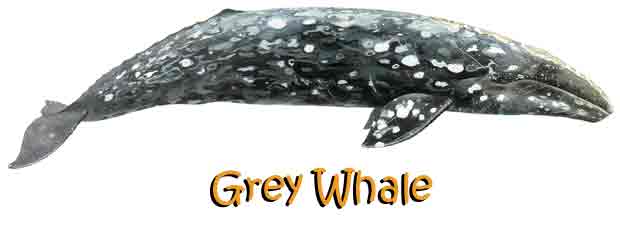
Habitat and Distribution | Physical Appearance | Behavior | Breeding and
Reproduction | Diet | Fun Facts
 Lots More: Sounds, Videos, Etcetera on Marine Mammals Lots More: Sounds, Videos, Etcetera on Marine Mammals
Habitat and Distribution
Grey whales (scientific name: Eschrichtius robustus) can be found in the shallow
coastal waters of the eastern North Pacific. These whales make one of the longest migrations of all mammals,
averaging 10,000 - 14,000 miles (16,000 - 22,400 km) round trip. The majority of grey whales leave the Bering Sea
in the North Pacific in mid-November to mid-December to make the long trip down to the warm waters of Baja California and the
Gulf of California. It is in these waters where mating and calving take place. From the Bering Sea, the whales travel down the
North American Pacific coast during the months of November through January or early February. Some whales do not
complete the southbound migration stopping off the coasts of British Columbia, Washington, Oregon or California. Migrating
whales stay close to shore in waters less than 600 feet (180 meters) until they reach Point Conception. At Point Conception the
mainland makes a sharp turn and at this point some whales decide to follow the coast and others decide to continue due south
through the Channel Islands. The southward trip to Baja and the Gulf of California takes 2 - 3 months. When they reach these areas,
the whales remain in the warm Baja lagoons for 2 - 3 months and allow the baby whales to build up a thick blubbery coat. Grey
whales then return north to the Bering Sea which takes another 2 - 3 months. On the northward journey mothers and
calves stay near shore the whole time. Some grey whales can be seen year round between Washington and the Vancouver Island and
off the central California coast.
Back to the top
Physical Appearance
Grey whales are a type of baleen whale. Baleen whales take their name from the bristly-fringed
plates called baleen, which hang down on either side of the whale's jaw. Whales use baleen to filter ocean water and catch small
animals swimming through the water. Grey Whales have the coarsest baleen of all whales with 130 to 180 baleen plates on each
side of their jaw. The body of a grey whale is streamlined with a narrow head.
Color: Grey whales are mottled gray in color. Their skin is usually
covered with many scratches, patches of white barnacles, blotches, scars, and abrasions. Orange marking may be seen
on the whale's body due to parasitic whale lice residing on the whale's skin. Newborns may appear dark gray to black, although
some have white markings.
Length and Weight: The typical length of a male grey whale is 39 to 46 feet
(12 to 14 meters) and a female grows slightly larger. Both females and males weigh about 30 - 40 tons.
Fins: Grey whales have no dorsal fins. Instead, they have a low hump followed by several knobs, called a dorsal ridge, which continue to the
tail stock. The flippers are large, paddle-shaped and pointed at the tips. The tail is very broad and wide reaching about 10 - 12 feet (3 - 4 meters) across.
Back to the top
Behavior
Grey whales can usually be seen in groups of 2 - 3 individuals. They are slow swimmers averaging
speeds of approximately 3 - 5 miles per hour during migration. They make 4 - 5 minutes dives and then surface to blow 3 - 4 times. When
feeding, Gray whales may be underwater for up to 15 minutes. Gray whales like to breech during migration and breeding
seasons. Breeching is when a whale leaps out of the water and reenters on its side, creating a large splash. These whales
are very protective over their young, and adults can often be seen swimming next to their babies.
Back to the top
Breeding and Reproduction
Grey whales reach sexual maturity at the age of 5 - 11 years or when the reach 36 - 39 feet (11 - 12 meters)
in length. Mating occurs in November and December during migration or once they reach the lagoons in Baja California after their
southbound journey. A female whale is pregnant for 12 - 13 months and babies are born every 2 - 3 years. A baby grey whale weighs
about 1,100 - 1,500 pounds (500 - 680 kg) at birth and reaches 16 feet (5 meters) in length. A calf nurses (drinks its mother's milk) for about 7 months.
Back to the top
Diet
Grey whales are benthic-feeding marine mammals. This means that they feed only on organisms living on or in
the sea floor. To feed, a whale dives to the bottom and then rolls on its side to grab a mouthful of mud or ocean floor
sediment. Grey whales use their baleen to filter out small crustaceans such as amphipods and tube worms. The food is caught
in the whale's baleen plates while the sediment and water is expelled though the baleen fringes. They feed primarily during the
summer months and rarely feed in wintering grounds. A grey whale can eat about 2,600 pounds (almost 1,200 kg) of food a day.
Back to the top
Fun Facts
- Grey whales make one of the longest migrations of all mammals averaging more than 10,000 miles (16,000 km) round trip!
- The only known predators of grey whales are killer whales and humans.
More Fun Facts on Grey Whales in Santa Barbara
from the Santa Barbara Educators' Roundtable
 Lots More: Sounds, Videos, Etcetera on Marine Mammals Lots More: Sounds, Videos, Etcetera on Marine Mammals
|

